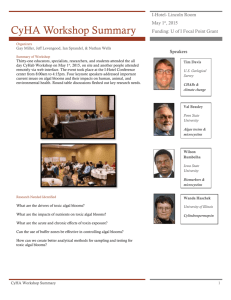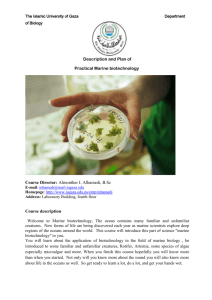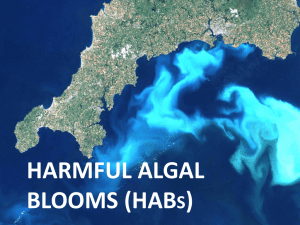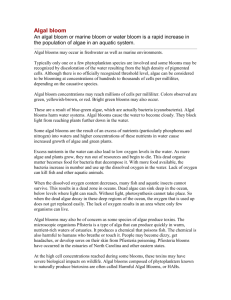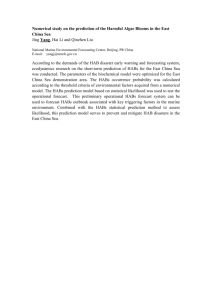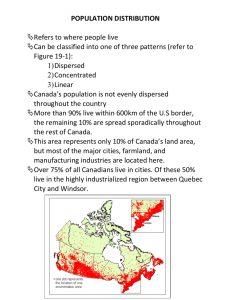The economic cost of harmful algal blooms in China from 2008-2012
advertisement
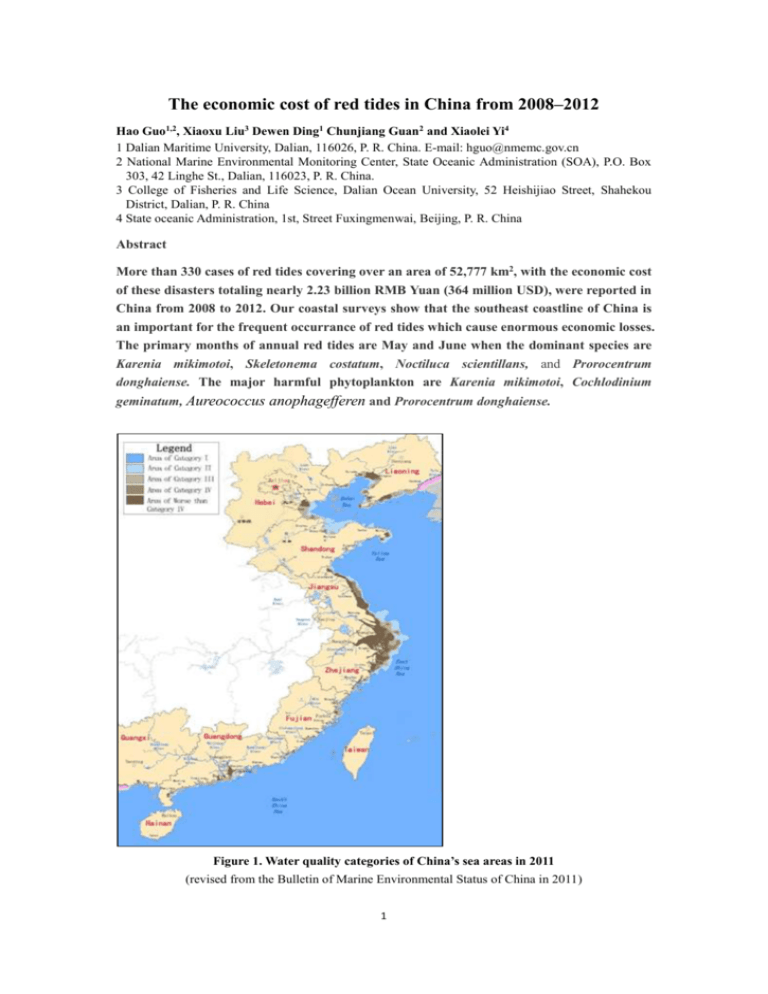
The economic cost of red tides in China from 2008–2012 Hao Guo1,2, Xiaoxu Liu3 Dewen Ding1 Chunjiang Guan2 and Xiaolei Yi4 1 Dalian Maritime University, Dalian, 116026, P. R. China. E-mail: hguo@nmemc.gov.cn 2 National Marine Environmental Monitoring Center, State Oceanic Administration (SOA), P.O. Box 303, 42 Linghe St., Dalian, 116023, P. R. China. 3 College of Fisheries and Life Science, Dalian Ocean University, 52 Heishijiao Street, Shahekou District, Dalian, P. R. China 4 State oceanic Administration, 1st, Street Fuxingmenwai, Beijing, P. R. China Abstract More than 330 cases of red tides covering over an area of 52,777 km2, with the economic cost of these disasters totaling nearly 2.23 billion RMB Yuan (364 million USD), were reported in China from 2008 to 2012. Our coastal surveys show that the southeast coastline of China is an important for the frequent occurrance of red tides which cause enormous economic losses. The primary months of annual red tides are May and June when the dominant species are Karenia mikimotoi, Skeletonema costatum, Noctiluca scientillans, and Prorocentrum donghaiense. The major harmful phytoplankton are Karenia mikimotoi, Cochlodinium geminatum, Aureococcus anophagefferen and Prorocentrum donghaiense. Figure 1. Water quality categories of China’s sea areas in 2011 (revised from the Bulletin of Marine Environmental Status of China in 2011) 1 China is a coastal country with 18,000 km of mainland coastline. The total sea area claimed under China’s jurisdiction is about 3,000,000 km2, including the Bohai Sea and the areas in the Yellow Sea, East China Sea and South China Sea1. There are more than 1,500 rivers flowing into these seas through broad drainage basins. China’s seas also boast of abundant marine biodiversity, with more than 22,600 species documented, and various types of marine ecosystems such as mangroves, coral reefs, sea grass beds, and coastal wetlands. In 2011, for example, the coasts of China were believed to be in good condition, as 95% of all sea areas met Seawater Quality Standard Category I standards (Fig. 1). The marine sediment quality in coastal waters has also been determined generally to be in good condition. However, some of the coastal areas have recently been subjected to adverse impacts of land-based pollution, environmental disasters, and habitat destruction. The occurrence of red tides may cause environmental pressures, such as anomalies in the seawater hydrochemistry and imbalances in marine ecology, with serious impacts on the eco-environment of China’s coastal areas. 1. Monitoring system for harmful algal blooms in China In order to understand the overall environmental status of the China’s sea areas, more than 9,800 survey stations were established in order to obtain over 2.5 million marine environmental data points. This national monitoring system of harmful algal blooms (HABs) began in 2002, with the establishment of 10 monitoring zones. Today, 19 HAB monitoring and control zones and 16 ecological monitoring and control zones are distributed along the Chinese coast to enhance the understanding of HABs. Monitoring and control zones for HABs were selected mainly in aquaculture areas, ecological protection areas, recreation resorts, and areas where HABs frequently occur. At present, China’s major means of monitoring marine red tides include fixed-point monitoring by ship surveys, satellite remote-sensing, and aerial remote-sensing. At the same time, monitoring at coastal stations and buoys, with subsequent laboratory testing, is used frequently. Panoramic and land-based monitoring systems greatly enhance the discovery of HABs and emergency response protocols play an important role in mitigating the impacts of red tides. 2. Algal blooms in China Red tides are important environmental problems in coastal areas and may do great harm to society and coastal economics. The first record of red tide in China is from 1933, and since that year, more than 1200 HAB events have been recorded. Specifically, there were only 14 cases of red tides before 1979, 75 cases in the 1980s, 226 cases in the 1990s, and nearly 1000 cases from 2000 to 2012 (Fig. 2). The frequency and scale of observed marine red tides reached a maximum during 2003– 1 Although the South China Sea is not in the PICES convention area, it is being included for completeness in this report, as these are part of China’s waters 2 2006. In addition, poisonous and harmful species have increased in recent years. It appears that the duration and frequency of HABs have increased; furthermore, their scope of influence and harmful effects have also increased. The characteristics of marine red tides include their duration, concentration, and spatial extent. Red tides may occur in China during all seasons of the year. In the Bohai and Huanghai sea areas, red tides occur in April–October every year, with the most intense spatial blooms occurring in July–September. In the East China Sea, red tides occur in February–October, with the highest concentration blooms in May– August. In the South China Sea, red tides occur all year round, with the periods of most concentrated blooms occurring mainly in March–May and August–November. The duration of individual red tides can range from 3–5 days to 2 weeks to over 1 month. In the 1980s, red tides were mainly found in small semi-enclosed bays. Since the 1990s, however, the occurrence of red tides has been recorded mostly in China’s nearshore waters. The results of monitoring show that the areas where red tides occur more frequently are located mainly along southeast China Sea and some bays as well as estuaries like Dalian Bay, Jiaozhou Bay, Hangzhou Bay, Shenzhen Bay, Daya Bay, the sea near the Changjiang River mouth, and the Zhujiang River mouth. The area of red tides in the Bohai Sea and the Changjiang River mouth is relatively large while those in the Zhujiang River mouth are relatively smaller, but with higher frequency. The scope of individual red tides has expanded from several km2 to thousands of km2 over the past two decades. 140 25000 120 Area 10172 Frequency 20000 53 100 80 15000 60 10000 40 5000 20 2012 Average 2011 2010 2009 2008 2007 2006 2005 2004 2003 2002 2001 2000 1999 1998 1997 1996 1995 1994 0 1993 0 Frequency of algal blooms Area of algal blooms (km2) 30000 Figure 2. HABs in China during the past 2 decades 3. The characteristics of algal blooms in China from 2008–2012 3.1 General observations There was an average of nearly 67 HAB events over an average affected area of 10,556 km2 in Chinese coastal areas annually from 2008–2012 (Fig. 3). The 3 occurrences of marine red tides and affected areas have remained relatively constant over the past 20 years. 80 Area 14000 Frequency 75 12000 10556 10000 8000 67 6000 70 65 60 4000 55 2000 0 50 2008 2009 2010 2011 2012 Frequency of algal blooms Area of algal blooms(Km2) 16000 Average Figure 3. Distribution of HABs from 2008-2012 Harmful algal blooms in Chinese coastal waters are located mainly in the East China Sea where the number of occurrences and areas are evidently much higher than in the other three Sea regions over these past five years (more than 57% of the total red tides and 54% of the total HAB area are in the East China Sea). On average, there were 7 events and an affected area of 2590 km2 in the Bohai Sea, 11 events and 1950 km2 in the Yellow Sea, 38 events and 5690 km2 in the East China Sea, 11 events and 321 km2 in the South China Sea every year (Figs. 4 and 5). Large-scale HAB events occurred mainly in marine waters adjacent to the Yangtze River estuary and in the southeast coastal waters of China. Frequency of algal blooms 50 Bohai Sea Yellow Sea East China Sea South China Sea 45 40 35 30 25 20 15 10 5 0 2008 2009 2010 2011 Figure 4. HAB frequency in 4 areas during 2008-2012 4 2012 Area of algal blooms (km2) 14000 12000 Bohai Sea Yellow Sea 10000 East China Sea South China Sea 8000 6000 4000 2000 0 2008 2009 2010 2011 2012 Figure 5. HAB scale in 4 areas during 2008-2012 3.2 Monthly distribution The occurrence of HAB events and affected areas showed a normal distribution. The main seasons of the annual events were from April–October, with the majority occurring in May and June. The number of occurrences and areas were much higher than in other seasons, with May and June events accounting for 52% and 73%, respectively of the total HAB events over the past five years (Figs. 6 and 7). Frequency of algal blooms 30 25 South China Sea East China Sea 20 Yellow Sea Bohai Sea 15 10 5 0 Jan Feb Mar Apr May Jun Jul Aug Sep Oct Figure 6. Monthly distribution of HABs from 2008-2012 5 Nov Dec Area of algal blooms (km2) 6000 5000 4000 South China Sea East China Sea Yellow Sea Bohai Sea 3000 2000 1000 0 Jan Feb Mar Apr May Jun Jul Aug Sep Oct Nov Dec Figure 7. Monthly distribution of HAB area from 2008-2012 3.3 Disaster-causing species and its toxicity There are more than 260 species of marine red tide organisms. About 90 species have latent toxins, most belonging to the group Pyrrophyta (Sournia, 1995). There are about 40 known genera and 140 species of red tide organisms in China. The dominant species are Karenia mikimotoi, Skeletonema costatum, Noctiluca scintillans, and Prorocentrum donghaiense. The major fish-killing organisms are Karenia mikimotoi, Cochlodinium geminatum, and Prorocentrum donghaiense. In many cases, algal blooms are considered harmless. However, it is when these algal blooms exceed a threshold level that they begin to have negative impacts on the environment and human health. Harmful algal blooms impact coastal fisheries by clogging gills of fish in captivity, depleting oxygen thereby causing hypoxia, and by production of toxins causing diarrhetic shellfish poisoning (DSP), paralytic shellfish poisoning (PSP), neurotoxic shellfish poisoning (NSP), amnesic shellfish poisoning (ASP), and ciguatera fish poisoning in humans. These red tides generally are of concern only when they are close to shore where they can impact coastal fisheries. 6 Fig. 8 The distribution of disaster-causing HABs from 2008~2012 Here, we will describe red tide events that have had negative impacts on the economy in coastal China (Fig. 8). In 2008, Noctiluca scintillans broke out in Liaoning Province. Although this species does not produce a toxin, it is found to accumulate toxic levels of ammonia which are excreted into the surrounding waters. It caused high mortalities of cultivated shellfish (Ruditapes philippinarum, Meretrix meretrix) and led to 2 hundred thousand Yuan (32.6 thousand USD) in economic losses (Table 1). Table 1. Major disaster-causing HABs events and direct economic losses (million USD) in China’s four seas regions Date Region Area (km2) Species June, 2008 Yellow Sea Noctiluca scintillans 500 May, 2009 East China Sea Noctiluca scintillans 30 May-June, 2010 Bohai Sea Aureococcus anophagefferen 7 3350 Affected species Loss (million USD) cultivated shellfishRuditapes philippinarum, Meretrix meretrix 0.03 maricultureSeriola quinqueradiata 1.14 cultivated shellfishArgopecten irradians 32.68 July, 2010 May, 2010 June, 2010 Bohai Sea East China Sea East China Sea Mesodinium rubrum 20 Prorocentrum donghaiense 30 Karenia mikimotoi 7 May-June, 2010 East China Sea Karenia mikimotoi Prorocentrum donghaiense 628 May-June, 2011 East China Sea Prorocentrum donghaiense 50 August, 2011 South China Sea Cochlodinium geminatum 89 cultivated shellfishArgopecten irradians cultivated fishPseudosciaena crocea cultivated fish & juvenile fish cultivated abaloneHaliotis discushannai Haliotis diversicolor mariculture-Epinephelus sp. Octopus vulgaris cultivated fish fry & juvenile fish-Ephippus orbis Epinephelus awoara 0.82 0.11 0.01 329.28 0.01 0.52 In 2010, Mesodinium rubrum spread to nearly 20 km2 and led to 5 million Yuan (0.82 million USD) in economic losses along Hebei Province, even though this species is rarely linked to damage. In 2011, economic loss of more than 3.2 million Yuan (0.52 million USD) was caused by Cochlodinium, which spread to a maximum area of 89 km2 in Guangdong Province, affecting fish fry and juvenile fish (Lateolabrax japonicas). Ichthyotoxins produced by Cochlodinium have caused major losses in fishery and shellfishery production in many countries. It is believe that this species expanded into Chinese coastal waters beginning in 2006. A comprehensive map of red-tide species found in China’s coastal waters in 2011 is shown in Figure 9). 8 Fig. 9. Distribution of red tides and dominant organisms in China’s watersin 2011. Oval inset shows remote sensing image of the waters off Liaoning Province. (revised from the Bulletin of Marine Environmental Status of China, 2011). In 2012, Karenia mikimotoi caused huge damage to the mariculture industries of Zhejiang and Fujian provinces, especially to cultivated abalone. The direct economic loss was more than 2 billion RMB Yuan (330 million USD). There are two major disaster-causing species in China. One is Prorocentrum donghaiense D. Lu, a very common species along the East China Sea in recent years, which frequently co-occurs with Karenia mikimotoi. Some experiments with this species show its specific damage to marine organisms. Another harmful alga is Aureococcus anophagefferens Hargraves & Sieburth which causes brown tides. From 2009–2012, with a maximum cell density around 109 cell/L, it caused huge damage to the scallop culture industry along Hebei Province. The bloom significantly damaged the mariculture industry in this region by causing cessation of feeding and stagnant 9 growth of scallops. For example, in May-June, 2010, it was responsible for 327 million USD economic loss. 4. Economic cost of HABs in China from 2008-2012 4000 350 3500 300 3000 250 2500 200 2000 150 1500 1000 100 500 50 0 Area Bohai Sea Yellow Sea East China Sea South China Sea 3370 500 745 89 Frequency 2 1 17 1 Loss(USD) 33.50 0.03 330.44 0.52 0 Direct economic loss (million USD) Area of algal blooms (Km2) 4.1 The direct economic loss of HABs in China’s four sea areas There were more than 330 cases of red tides in China from 2008 to 2012, encompassing a total area of 53,000 km2, with an economic cost of nearly 2.23 billion RMB Yuan (364 million USD). These red tides caused great harm to marine fisheries, resulting in enormous economic losses. The hardest hit areas were mainly in southeast Chinese coastal waters, where 17 disastrous HABs broke out and led to direct economic loss, accounting for about 91% of the total losses. But the largest scale HAB events were in the Bohai Sea (Fig. 10). Figure 10. Direct economic loss of HABs in 4 areas from 2008-2012 4.2 Annual variety of economic loss from 2008–2012 Two significant features of economic loss in China are shown in Fig. 11. The first is that the largest area of HABs (about 3350 km2), caused by Aureococcus anophagefferen occurred in May–June 2010, in Qinghuangdao, Hebei Province. The highest direct economic loss, of about 2.02 billion RMB Yuan (330 million USD), occurred in 2012 and accounted for about 91% of the total documented losses due to red tides (Fig. 11). The main species responsible for this costly event was Karenia mikimotoi which affected cultivated abalone. The average annual loss during the 2008–2012 ti was 446 RMB Yuan (73 million USD). 10 Area of algal blooms (Km2) 350 3500 300 3000 250 2500 200 2000 150 1500 1000 100 500 50 0 Area 2008 2009 2010 2011 2012 Average 500 30 3407 139 628 940.8 Frequency 1 2 4 2 12 4.2 Loss(USD) 0.03 1.06 33.66 0.53 329.25 73 0 Direct economic loss (million USD) 4000 Fig.11 Direct economic loss of disastrous HABs during 2008-2012 5. Summary China is a major maritime country. The ocean occupies an important strategic position in China’s national economy and social development. However, while the marine development and the coastal economy in China are advancing rapidly, several problems impacting the marine environment must be considered. With yearly increases of nutrients and organic compounds polluting the sea, marine red tide disasters have also occurred more frequently. The main disaster-causing species are Karenia mikimotoi, Skeletonema costatum, Aureococcus anophagefferen, Noctiluca scintillans, Cochlodinium geminatum, and Prorocentrum donghaiense. There were nearly 70 cases of HABs over approximately 10,560 km2 annually from 2008 to 2012, accompanied with the total direct economic cost of nearly 450 million RMB Yuan (73 million USD). The southeast coastal area of China is an important fishery area where red tides occur frequently, causing enormous economic losses. The worst-hit species affected by these red tides are cultivated abalone (Haliotis discus hannai, Haliotis diversicolor), scallop (Patinopecten yessoensis, Argopecten irradians, Chlamys farreri) and fish (Lateolabrax japonicas). Harmful algal blooms are a global marine issue as well as a major marine disaster in China. Management and disaster mitigation are of great importance in China. Mitigation efforts should be focused on the adverse impact of land-based pollution that can result in environmental disasters and habitat destruction. This should be an area of future research and management. References [1] State Oceanic Administration, Bulletin of Marine Environmental Status of China in 2011. www.soa.gov.cn/zwgk/zghyhjzlgb/201211/t20121107_5527.html. [2] Hallegraeff, G. M., 1995. Manual on Harmful Marine Microalgae. UNESCO. [3] GUO Hao, WANG Jian-guo, YI Xiao-lei, ZHAO Wen, FENG Zhi-quan, GUAN Dao-ming, 2004. Illustration of Planktons Responsible for the Blooms in Chinese Coastal Waters. Beijing, China 11 Ocean Press. [4] KONG Fan-zhou, YU Ren-cheng, ZHANG Qing-chun, YAN Tian, ZHOU Ming-jiang, 2012. Pigment characterization for the 2011 bloom in Qinhuangdao implicated “brown tide” events in China. Chinese Journal of Oceanology and Limnology, 30(3): 361-370. [5] ZHOU Ming-jiang, ZHU Ming-yuan, 2006. Progress of the Project/Ecology and Oceanography of Harmful Algal Blooms in China. Advance in Earth Science, 21(7): 673-679. [6] ZHOU Cheng-xu, WU Yu-lin, 1999. The Trigger and Regulation Mechanism of Dinoflagellate Red Tide and Its Toxin and Metabolism Pathway of Nitrogen in Noctiluca scintillans. Oceanologia et Limnologia Sinica, 30(4): 454-459. [7] WANG Zhao-hui, LIN Lang-cong, KANG Wei, SHAO Juan, ZHANG Ke, 2011. Progresses in studies on harmful algal bloom species Cochlodinium Sch.tt. Journal of Jinan University (Natural Science), 32(1): 109-114. [8] KE Zhi-xin, HUANG Liang-min, TAN Ye-hui, SONG Xing-yu, 2012. A dinoflagellate Cochlodinium geminatum bloom in the Zhujiang (Pearl) River estuary in autumn 2009. Chinese Journal of Oceanology and Limnology, 30(3): 371-378. [9] Sournia A. 1995. Red tide and marine phytoplankton of the world ocean: an inquiry into biodiversity. In: Lassus P, Arzul G, Denn E et al. (eds). Harmful Marine Algal Bloom. London, New York, Paris: Technique&Documentation LaVOisier/Andover, England UK: Intercept Ltd. 12
